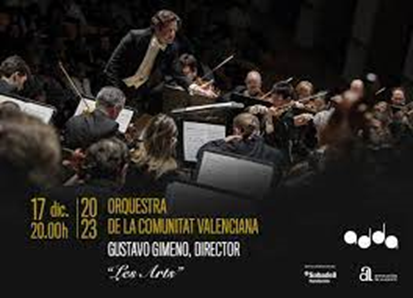Of all operas, there are a couple by Leos Janacek that
I would profess to ‘know’, in that I have seen multiple productions, read and
studied the libretti, listened to the music literally hundreds of times and
read around the creation and setting. Jenufa would be one of them, all the way
from an early 1970s production at Covent Garden in London, where it was sung in
a clumsy English translation, through to last night’s offering in Valencia,
where the Dutch National Opera’s production took the story out of rural, nineteenth
century Moravia, and gave it a contemporary setting, more like a movie than a
staging.
To start with the staging is perhaps an injustice to the
performances, but that is where we are. This production, in order, perhaps, to
emphasize the cinematic concept, featured an elevated space that was set back
from the front of the stage. It was a lit rectangle, just like a movie screen.
It provided a space that could be subdivided to provide multi-roomed interiors,
complete with ceilings. It was a production where everything happened ‘inside’,
even in act one, a factor that concentrated attention on the internal conflicts
of the characters. Visually, it also concentrated attention on the characters’
actions. Everyone had to enter the space via a door and the rooms’ walls and
ceilings seemed to focus attention on the psychological drama that unfolded. A
drawback with this design, however, was the enclosure it created, a closure
that rather deadened any sound that did not come from the very front of the
set. In act one of Jenufa, there are movements in an out, on and off stage, and
this set meant that there were moments when the singers fought to make
themselves heard from within the rather insulated space.
In acts two and three, of course, there is a much
greater concentration on the psychological drama than the introduction of
protagonists, and it was here that the set came in to its own. In act two, for
instance, when Jenufa is given a sleeping draught by the Kostelnicka, she has
to retire to her bed, and this is often offstage, out of view. Here, as part of
her concealment from public gaze, the room she occupied was set below the
stairs amid gas pipes, drainpipes, and electricity meters. But this staging
allowed her to remain centre stage, and, although asleep, in full view of the
audience. And thus, while ever she remained centre stage, she still seemed to
figure in the dialogue the other characters shared. And far from diverting
attention from the interactions between Kostelnicka, Steva and Laca, the
continued presence of Jenufa kept her character of the centre of the argument.
This single design element allowed Jenufa’s solo, after Kostelnicka had already
taken her baby away, to flow with the same psychological force of what had gone
before, rather than become a new episode.
Act one of Jenufa is written in a different musical
language from acts two and three. Nine years intervened between act one and the
opera’s completion. Changes in compositional style are mirrored in how folksong
is treated. In act one, the folk song is exactly that, literal, rooted
harmonically, and very much a partygoers’ sing-along. By the time he had
written the folk song melody that forms the choral passage in act three, where
the girls celebrate Jenufa’s wedding, the musical language has been
transformed. Yes, it’s celebratory, but
there are question marks everywhere, because the song doesn’t easily find a
key. Yes, it’s modal, but now not sweetly so.
In this staging, the toilet plays a central role, at
least, in act one. Placed centre stage, it was used at the start of the action
by Jenufa, who has a bout of sickness, emphasizing from the start that her
pregnancy is the main issue. In a beautiful moment, during Kostelnicka’s diatribe
about Steva’s drunkenness, when she relates her own experience of an abusive
husband, one of the previously partying women retires to the toilet and
silently grieves at her own circumstances as the words outside describe
domestic troubles. This stresses the ongoing issue, the past for Kostelnicka,
perhaps the avoidable future for Jenufa, but also the present for the silent
partygoer.
And toilets figure elsewhere. Steva, unable to stomach
the criticism in act one, retires, like a spoiled child to the washroom at the
side to avoid having to listen. When things get tense in act three, a character
retires to the toilet on the edge of the set for a moment of privacy. All of
this adds to the internal nature of the drama, the fact that we are always
dealing with how individuals cope psychologically with pressure, with
challenge, with opportunity, with options. They have to think things through,
and even still might come to the wrong conclusion.
What perhaps none of us rationalizes are the emotions
that give rise to physical attraction and sex. Here we are driven by feelings
that often control us and take us over before we are even conscious of them. Jenufa
is clearly besotted with Steva and continues to be so until, very late on, she is
won over by Laca’s albeit flawed devotion. The irrational passion that is in
all of us thus explains how the responsible, sensible, caring, competent Jenufa
got pregnant in the first place. It also justifies how this particular staging
ends, with Jenufa and Laca, rather than walking hopefully towards a better
future, get down to having sex the minute the guests have left their tragic
wedding. The sensuality, after all, is there in the music.
And, at last, I can turn to praising the Jenufa of Corinne
Winters. A more convincing, complete portrayal of the role has perhaps never
existed. Roberta Alexander was superb, if a little too suffering. Asmik
Gregorian has recently claimed the role for herself with a unique blend of
vulnerability and steadfastness. But this evening’s performance by Corinne
Winters adds much to this role. Corinne Winters’ Jenufa is a complete and
credible modern woman, professional, competent, caring, needing love and
affection, passionate, responsible, vulnerable, realistic… the list could be
endless. Let’s say human. This, after all, is a complete person, with all the
contradictions and qualities that implies.
In act one, Jenufa is in her office, the young
competent professional, though abused, perhaps as much by her own passion as by
Steva’s insistence. In act two, she is in a jumpsuit for lounging around the
house. The elegance has gone, the work-a-day requirements of being a mother
having taken over. In act three, she is in white, hardly the ‘dressed like a
window’ of the libretto, but the white becomes a statement in itself, a
determination to look to the future, however, limited its boundaries may
appear. Perhaps the most moving moment of the story happens when Kostelnicka,
having just drowned the baby in act two, tells Jenufa that she has been in a
fever, and that the baby has died. How easy would it be to revert to paroxysms
of pain, histrionics of emotion? Here, Corinne Winters, merely sinks to her
knees in her jumpsuit, and stays there, devastated, visibly emotionally
destroyed.
Petra Lane, this production’s Kostelnicka, gave a
moving and convincing performance of this truly demanding role. One was never
in any doubt she was convinced that she was doing the right thing. The guilt of
the third act was perhaps a little under-played, but this was probably as
directed.
The two men in the principal roles often do not often figure
significantly in reviews of Jenufa. They can all too easily become stereotypes.
But here they too were rounded human beings, if that term can be applied to the
selfish, self-interested, self-obsessed character of Steva. Norman Rheinhardt’s
portrayal made the character’s flaws apparent, however, and though never
excusable, they became understandable.
Brandon Jovanovich’s Laca, however, was nothing less
than revelatory. Here we have a character complex enough to be in love with a
woman he physically abuses. But he is ultimately trustworthy and dependable,
and here, also, passionate. Brandon Jovanovich’s voice is a perfect match for
the part. I never thought I would hear a more convincing Laca than Philip
Langridge, but Brandon Jovanovic has indeed made this character his own.
And finally - finally? - the music. Janacek’s score, especially in the final
two acts is a masterpiece. The music never dominates, but always contributes.
It adds subtle pictures to illustrate and define the psychological drama, often
creating that drama via the juxtaposition of small cubist planes and
perspectives, so that emotions flutter around an idea that can be seen from
multiple viewpoints. Janacek’s musical language is so subtle and so
communicative that it cannot be described in words. And like all languages, it
does take time to learn, but once familiar, it says so much that is different,
and that is original, inexpressible in any other way, or perhaps by any other
composer.
Gustavo Gimeno‘s reading
of the score emphasized the subtlety and sheer physical beauty of the sound,
rather than the composer’s characteristic spikiness. But this reading of the
score did emphasize the normality of the people depicted and the universality
of their dilemmas. The production proved to be an emotional roller coaster, but
overall, it’s gentle contours stressed its
everyday significance. It will live long in the mind, and, hopefully, long on
the stage.











